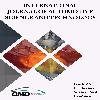Experimental Investigation of the Effect of Brake Disconnished by Hvof Method
In this study; brake discs used in vehicles have investigated. The behavior of these discs during braking, wear and braking distance performance of the coated and uncoated surfaces during the braking process were evaluated. The surface of the commercially produced discs was coated with a thickness of 1 mm using the HVOF (High Velocity Oxy-Fuel) coating method. In the coating process CoNiCrAlY, WC-Co (88/12), NiCrBSi and MoNiCrBSiFe (Mo 25%) 4 (four) different ceramic powders were used respectively. Wear and brake distance tests of coated and uncoated discs were performed by braking in a total of 20 brakes in 15 seconds on the brake-suspension tester. After the brake tests, the surface roughness changes of the discs, surface hardness change, mass loss and the abrasion values on the disc surfaces were determined due to the brake force applied to the discs during the experiment. The most wear on the discs was on the CoNiCrAlY ceramic powder coated disc at 0,4 g, while the least wear occurred on the disc coated with NiCrBSi ceramic powder at 0,2 g.
Keywords:
Brake Disc, HVOF, Brake Test, Wear, Ceramic,
___
- [[1] Bayrakçeken, H. (2002). Motorlu taşıtlarda fren performans analizi ve geliştirilen test cihazında uygulanması. Gazi Uni-versity Institute of Natural and Applied Science, PhD Thesis.
- [2] Düzgün, M., Yıldız, Y. (2009). Soğutma Kanallı Fren Disk-lerinin Frenleme Kuvvetlerine ve Isı Değişimine Etkileri. In-ternational Advanced Technology Symposium, Karabük, Turkey.
- [3] Ulutan, M. (2007). AISI 4140 Çeliğinin Yüzey Sertleştirme İşlemleri Ve Kaplama Yöntemleri Sonrası Mekanik Dav-ranışlarının Araştırılması. Eskisehir Osmangazi University, Institute of Natural and Applied Science, PhD. Thesis.
- [4] Deamaley, I.(1985). Adhesive, abrasive and oxidative wear in ion-implanted metals. MaterialsScience-Engineering, 69:139-147.
- [5] Seong, K.R. Michael, G.J. ve Peter, H.S.T. “The role of friction film in friction, wear, andnoise of automotivebrakes”, ABS Traction Control andBrake Components, SAE: 900004, 1990.
- [6] Anderson, A.E. (1992). Friction and wear of automotive brakes, in: ASM Handbook: Friction, Lubrication and Wear Technology, ASM International, Materials Park, OH, 18:569-577.
- [7] Bergmann, F., Eriksson, M., Jacobson, S. (1999). A soft-ware based measurement system or test and analysis of au-tomotive brake squeal. Tribo Test Journal. 5(3):265-275.
- [8] Demir, A. (2009). Fren Disklerine Uygulanan Kaplamaların Frenleme Performansına Etkisinin Deneysel İncelenmesi. Kocaeli University, Institute of Natural and Applied Science, Ph.D Thesis.
- [9] Erdem, M., Altıparmak, D. (2014). Fren Disk Sıcaklığının Frenleme Performansına Etkisi. Gazi Üniv. Müh. Mim. Fak. Der. Cilt 29, No 2, 425-432.
- [10] Ericksson, M., Bergman, F. Jacobson, S. (2002). On the nature of tribological contact in automotive brakes, Wear, 252: 26-36.
- [11] Filip P. Weiss, Z. D. Rafaja, D. (2002). On friction layer formation in polymer matrix composite materials for brake applications. Wear, 252: 189-198.
- [12] Güney, B., Mutlu, I. Dry friction behavior of NiCrBSi-%35W2C coated brake disks. Material pruefung/Materials Testing. 59(5):497-505, 2017.
- [13] Kao, T.K. Richmond, J.W. Douarre, A. (2000). Brake disc hot spotting and thermal judder: an experimental and finite el-ement study, International Journal of Vehicle Design, 23, 3-4, 276-296.
- [14] Kaya, A. Ö. (2007). Plazma Püskürtme Ve Hvof Yöntemleri Kullanılarak Cr3c2nicr(75/25) ve Crnibsi+%80 Wc-Co To-zlarıyla Kaplanan Çeliğin Yapısı Ve Yüzey Özellikleri. Gebze Technical University, Institute of Natural and Applied Science, Master Thesis.
- [15] Lee, K. Barber, J.R. (1994). An experimental investigation of frictionally excited thermoelastic instability in automotive disk brake sunder a drag brake application, Journal of Tri-bology.116, 3, 409–414.
- [16] Mutlu, İ. (2002) Seramik Katkılı Asbestsiz Otomotiv Fren Balatası Üretimi ve Frenleme Karakteristiğinin Deneysel İncelenmesi. Sakarya University Institute of Natural and Ap-plied Science, Ph.D Thesis.
- [17] Shorowordi, K.M.,Haseeb, A.S.M.A., Celis, J.P. (2004). Velocity effects on the wear, friction and tribochemistry of aluminium MMC sliding against phenolic brake pad, Wear, 256: 1176-1181.
- [18] Stanford, M.K. and Jain, V.K. (2001). Friction and wear characteristics of hard coatings. Wear, 250/51, 990–996.
- [19] Stokes, J. (2003). Production of coated and free-standing engineering componenets usingt he HVOF process. Dublin City University, Ph.D Thesis.
- [20] Thuresson, D. (2004). Influence of materialproperties on slidingcontactbrakingapplications. Wear. 257, 451-460.
- [21] Toros, M. (2011). Fren Balatalarında Nano Malzemelerin Kullanımının Frenleme Performansına Etkilerinin Deneysel Araştırılması. Selcuk University Institute of Natural and Ap-plied Science, Master Thesis.
- [22] Karanfil, S. (2017). Fren disklerinin HVOF Yöntemi ile kaplanması ve taşıtlarda fren performansına etkisinin araştırılması. Afyon Kocatepe University, Master Thesis.
- Yayın Aralığı: Yılda 4 Sayı
- Başlangıç: 2016
- Yayıncı: Otomotiv Mühendisleri Derneği
Sayıdaki Diğer Makaleler
Investigation of Polymer Matrix Metarials in Automotive Consoles
Mehmet Çakmakkaya, Mehmet Kunt, Oğuzhan Terzi
Investigation of Polymer Matrix Composites in Automotive Consoles
Mehmet ÇAKMAKKAYA, Mehmet KUNT, Oğuzhan TERZİ
Mustafa Babagiray, Hüseyin Bayrakçeken, Mehmet Çakmakkaya, Faruk Emre Aysal, Salih Karanfil
